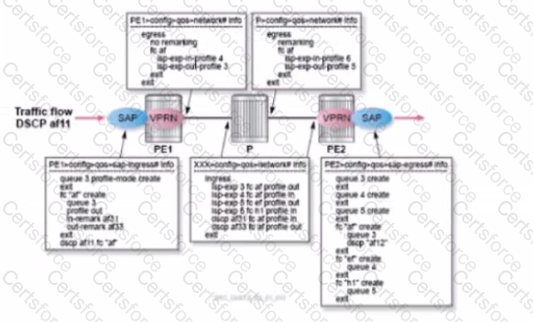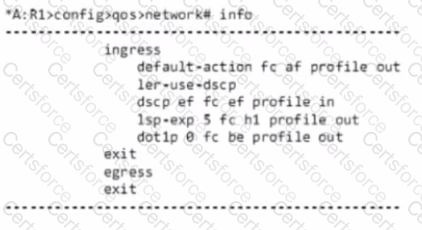Packets arrive at the VPRN SAP on PE1 with DSCP marking of all. According to the QoS policies applied at routers PE1, P, and PE2, what is the DSCP value of packets egressing router PE2? (All the SDPs are MPLS-encapsulated, and all interfaces are using their default trust states).

How many bits does DSCP use to provide QoS marking options?
Which of the following is NOT one of the four elements in the Nokia 7750 SR QoS solution'
Which of the following statements about standalone pokers and CFHP policers is FALSE?
A default network policy is applied to all router interfaces associated with network ports.
Which of the following is NOT a benefit of using a spoke SDP in an H-VPLS design?
In the image shown above, the network QoS policy is applied properly to a Nokia 77S0 SR acting as a transit Label Switch Router (LSR) for a given MPLS tunnel. A packet is received inside the MPLS tunnel with EXP=5, dotlp=0, and DSCP=EF. Which forwarding class is assigned to this packet?

Which of the following BEST describes a SAP when regarding QoS?
Which of the following about self-generated traffic QoS is TRUE?
Traffic assigned to forwarding classes is placed into queues, while the contents of the queues are serviced in a controlled manner using____________.
On the Alcatel-Lucent 7750 SR, which of the following QoS-related policies can be configured on a SAP? (Choose three)
If packets egressing a SAP do not match any criteria defined in the SAP-egress policy, which forwarding class will these packets be assigned to?
Which of the following parameters are used in a hierarchical scheduler-policy to specify the priority of the child scheduler/queue for allocating bandwidth beyond its committed rate? (Choose two)
Which of the following rate-limiting approaches are used on the Alcatel-Lucent 7750 SR? (Choose two)
Click the exhibit button below. Given that the slope-policy (below) has been enabled and applied on a network port, which of the following statements are TRUE? (Choose three)
